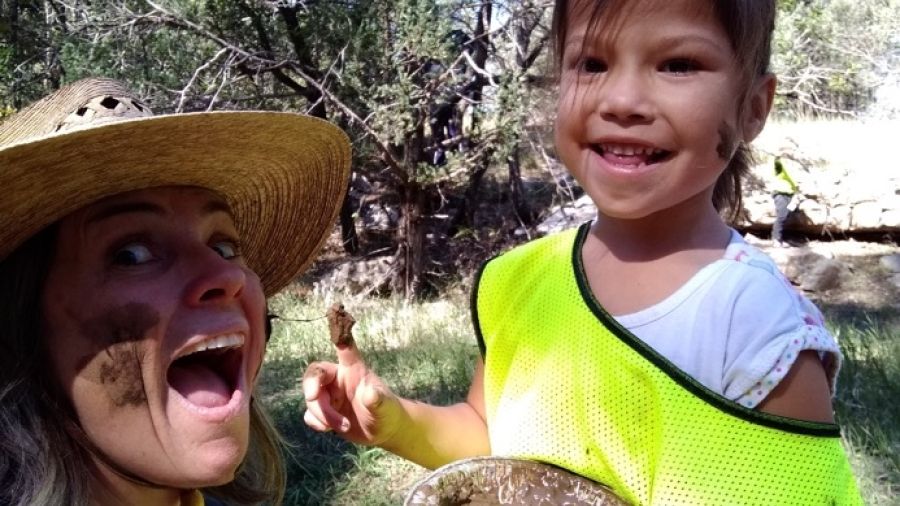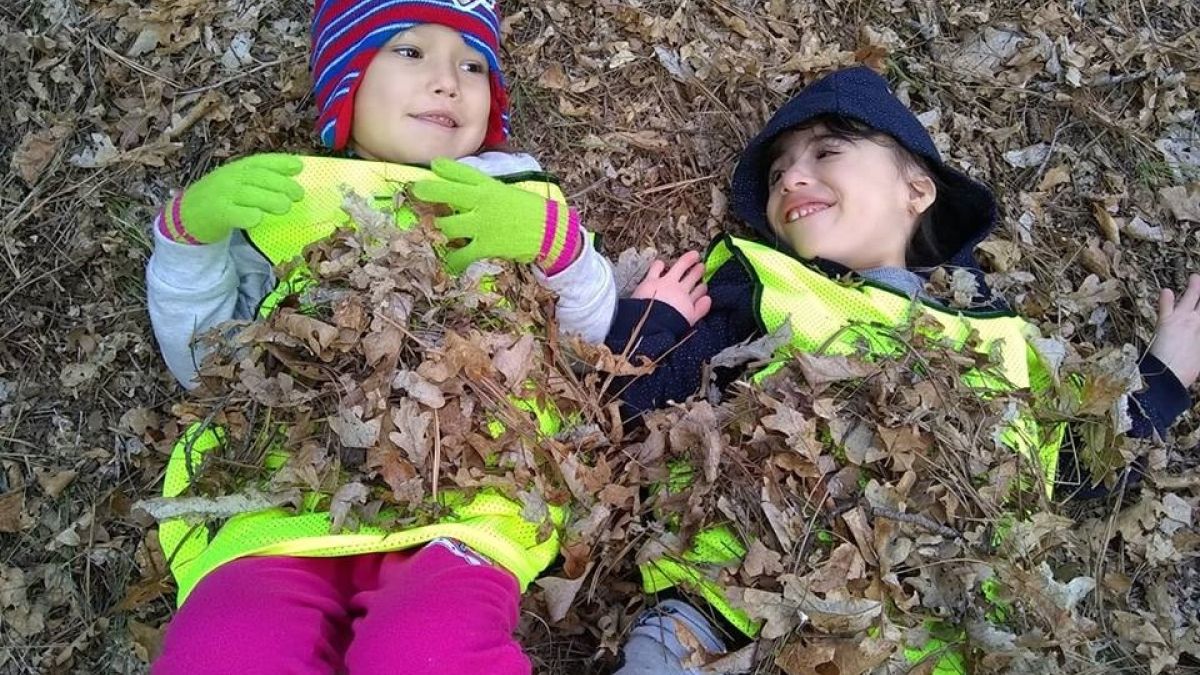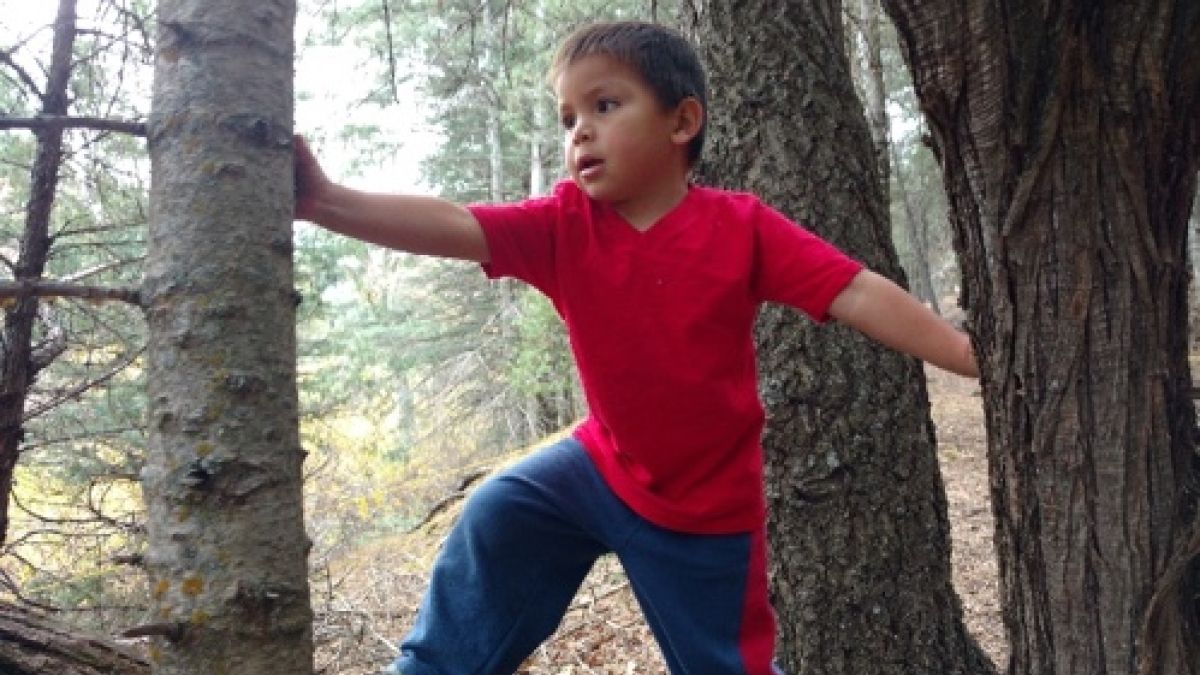
“I love going to the forest because I can climb big trees! And you know what else…? I can break sticks because I am strong!” – Sage, age 4
I have worked with children who are deaf / hard-of-hearing (DHH) for decades, in a variety of roles and locations, and, because of my own love for the natural world, I have long sought ways to connect DHH students to nature. In 2011, following my reading of Richard Louv’s Last Child in the Woods, our preschool at the New Mexico School for the Deaf began regular visits to a local nature center. This was a fabulous introduction to place-based education, but we ran into trouble when we wanted to build forts or throw rocks into the river because the area we visited was technically a protected park. This limited our outdoor experience, so we began to rethink things. In 2015, while doing some research, I read two words that instantly resonated with me: Forest School.
From Idea to Reality
In my twenties, I had worked as an outdoor educator and my desire was to combine my passion for nature with Deaf Education. There was no permanent work to be had though, so I stepped fully into the Deaf Education field, eventually specializing in early childhood. When I learned about the Forest School model, I immediately knew that this was something our DHH children would benefit from and that it would fit nicely into our existing Reggio Emilia-inspired preschool programs. I also knew I would need to be officially trained in the Forest School philosophy in order for the school to agree to pilot a program. So, in the spring of 2016, I started my Practitioner training with Forest Schools Canada, while also pitching the idea of programming to our administration. Soon, the Forest Day Learning (FDL) program was born in Santa Fe. Now in our third year of operation, we are the first school for the Deaf in the country to offer a Forest School component. Last year we launched an FDL program at our Albuquerque-based preschool, and this spring we hope to get one going at our Farmington, NM facility, as well.
The programs begin with our 18-month-olds, who enjoy their FDL time at parks that are wooded and void of built play structures. Toddlers then “graduate” to regular visits in the forest once they are three. In Santa Fe, we use a site in the Sangre de Cristo Mountains; in Albuquerque, we use a site in the Tijeras Canyon. Each class enjoys FDL once every 2-3 weeks for 2-4 hours, to add up to at least 10 visits to the same site throughout the school year. All of our staff have been trained and we also provide opportunities for parents to learn about FDL and the many benefits of time spent outdoors in nature.

Image credit: New Mexico School for the Deaf
Unique Considerations for Deaf and Hard-of-Hearing Students
The biggest initial challenge was in de-programming students from their highly-scheduled and highly-structured lives. Most modern children tend to be faced with similar circumstances, but when a child is deemed to have a disability, their lives are typically even more controlled. Add to this the fact that they are also often sheltered, “bubble-wrapped,” and rarely allowed to experience risk in any way, and it’s no surprise that, initially, the majority of our students stood around, wondering what to do in the forest. We had to teach them to engage with the land and play freely again!
In our programs, we are frequently working with children who have significant language delays, even in American Sign Language (ASL). This creates a unique situation in relation to managing risk in the forest, but we found that it helps to offer many visual supports to assist the children in learning to stay safe. Examples include neon cording to mark the forest classroom perimeter, pinning a laminated card up on a tree with a picture of two children climbing and the number ‘2’ (for “two children climbing at a time”), and waving a colorful flag to prompt the children to gather for drills. We have expanded upon these concepts for our students who have additional needs, such as Autism, by taking pictures of the forest classroom and creating “picture symbols” or by adding tactile components to our learning supports.
We realized early on that we would need to pre-teach concepts and vocabulary, and offer lots of repetition, to allow for safety “awarenesses” to sink in. For example, an adult could support a hearing child’s tree climbing activity by asking questions like, “What’s your next move?” or “Notice how that branch looks strong compared to that one?” This technique is not doable when you have a Deaf child that uses ASL up in a tree! If they were to remove both their hands to sign, we’d be looking at a hazardous situation, so we taught this skill by making a mini-movie of our teachers climbing trees. The children learned that we would not offer help climbing and that they should not climb any higher than they felt comfortable. They also learned that they should let an adult know when they are planning to climb, state that they are ready to climb (much like rock climbing), and then think about always maintaining three points of contact with the tree. This movie was shown to all of our classes and embedded into a rich dialogue about staying safe in the forest.

Image credit: New Mexico School for the Deaf
Looking Ahead
We have noted immense growth in our FDL children since the program’s inception. We have documented improvements in their descriptive use of ASL, ability to check in with their bodies, inquiry skills, motor skills (particularly with children who have gross motor delays), social play, self-confidence, and perhaps most importantly, their sense of joy. In addition, parents have changed their view of their child’s capabilities. We are currently looking at ways to better measure learning outcomes in the forest, in part to legitimize the continuation of FDL long into the future. However, as a seasoned educator, I can anecdotally share that I have never seen any kind of curriculum, technique, or new approach have greater impact on the overall learning of young children than Forest School does. This shouldn’t be a surprise, given that it’s how young humans have learned for generations!
About the Author
Sally Anderson is Site Principal at the Albuquerque Preschool of the New Mexico School for the Deaf. She has worked in Deaf Education for 30 years and is an avid outdoor enthusiast. In addition to serving as NMSD’s FDL Lead, Sally also founded and teaches at a small, private Waldkinder - Sol Forest School - in the mountains east of Albuquerque. She is one of the first Forest Therapy Guides in NM offering Shinrin Yoku walks and is trained through the Association for Nature and Forest Therapy (ANFT). Sally believes it is our sacred duty as early childhood educators to create opportunities for young children to connect to the natural world. Stay in touch with Sally at https://www.facebook.com/soulfuloutdoorlearning/